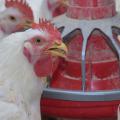Management of egg producing hens
The housing and management of layer hens can be carried out using one of two methods, caged layer production or floor production. Use of either method can keep the hens in production throughout the year if proper environmental and nutritional needs are met.
The poultry house should be located away from other farm structures. The ground should allow good water drainage. Adequate light fixtures are needed to provide proper light intensity. Adequate light is present if the water and feed levels in the troughs can be seen after allowing enough time for your eyes to adjust to the dim lighting. Fresh, clean water should be available at all times.
The house should allow for plenty of ventilation and sunlight. Place 1 inch, poultry wire netting over all openings to separate the hens from other birds and animals, both wild and domestic. Removable curtains or doors are recommended so the openings can be opened or closed as the weather changes. Keep the house dry and comfortable by ventilating from all sides in the summer and closing most openings in winter.
The caged layer production method consists of placing the hens in wire cages with feed and water being provided to each cage. The birds are housed at a capacity of two to three hens in each cage, which measures approximately 12"x16"18". The cages are arranged in rows which are placed on leg supports or suspended from the ceiling so the floors of the cages are about 2 to 3 feet above the ground. Water is supplied by individual cup waterers or a long trough outside the cages that extends the length of the row of cages. The feed trough is also located outside the cages and runs parallel to the water trough on the opposite side of each cage. The cages are designed so the eggs will roll out of the cage to a holding area by means of a slanted wire floor. This method of housing is used primarily with egg-type layers kept for infertile egg production.
The floor production method is designed for either egg-type or broiler-type birds kept for fertile or infertile eggs. In commercial flocks this method is used when fertile eggs for hatching are needed. The birds are maintained in the house on a litter covered floor, giving the term floor production.
One nest 14 inches wide, 12 inches high, and 16 inches deep is needed for each four hens. A mash hopper 5 feet long and open on both sides is adequate for 25 hens. Three 3-gallon pans provide adequate watering space for 30 hens. Clean, scrub and disinfect the house and equipment thoroughly before placing the pullets in the laying house after it has dried. Put 3 inches of litter material in the nests and 4 to 6 inches of litter on the floor.
Regardless of which production method is used, the 22-week old pullets should be given an increasing daily light schedule after being placed in the laying house. The length of daily light should be increased 15 minutes each week after the birds enter the laying house. The increased light will stimulate egg production and help maintain production throughout the year. The day length increases should continue until the birds are receiving 16-18 hours of light each day. The day length should remain the same for the rest of the laying period. After the birds begin to produce eggs, the total duration of light, including both natural and artificial, should not be reduced.
The birds should be fed a nutritionally balanced commercial laying mash containing 16 percent protein. Use a special breeder ration if the eggs are being saved for hatching purposes. These breeder diets contain higher levels of vitamins that help produce higher hatchability and healthier chicks. Poultry older than 16-18 weeks do not require a ration containing a coccidiostat unless a coccidiosis outbreak occurs. If a commercially produced layer ration is provided, additional oyster shell, grit or grain is not needed.
Broodiness is often a problem in floor production housing. It is characterized by a hen wanting to build a permanent nest and begin "setting." The problem can be solved by removing the hen from the flock and placing her in a wire-floored cage for 3 to 4 days. Ample feed and water should be supplied to the affected hen. The hen can then usually be returned to the flock with no further problem. The treatment can be repeated if the hen continues to be broody.
Additional information for managing the egg flock for maximum productivity is found in Culling Hens.
Publications
News
STARKVILLE, Miss. -- Until an avian flu vaccine for chickens or other alternative is federally approved, commercial poultry operations in the U.S.
STARKVILLE, Miss. -- If egg prices have seemed higher than ever lately, it’s because they are, and consumers can place much of the blame squarely at the feet of the ongoing bird flu outbreak.
With highly pathogenic avian influenza, or HPAI, in the environment in Mississippi, owners of backyard flocks have to take extra steps to keep their chickens healthy.
Avian influenza poses an extremely low risk to human health and none to food safety in Mississippi, but its presence poses a risk to backyard flocks and the state’s $3 billion commercial poultry industry.







